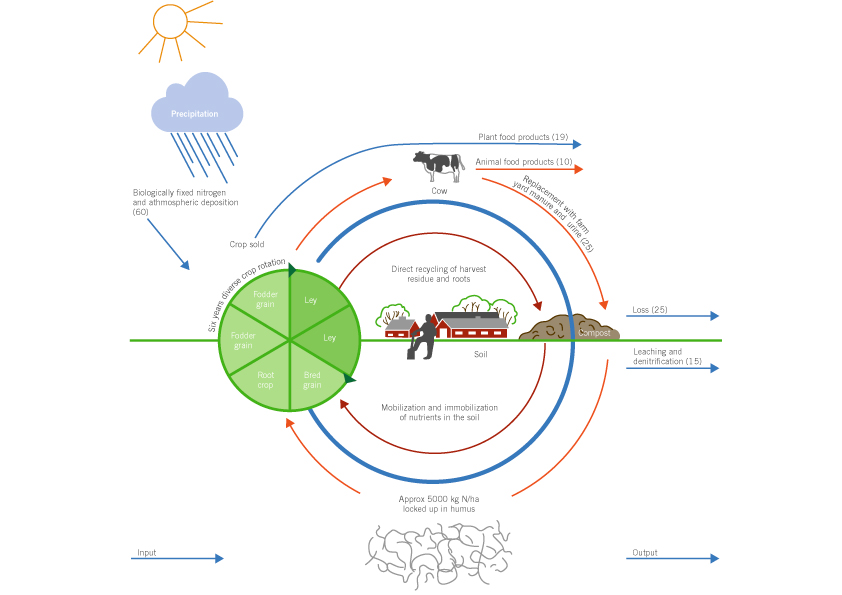Why is an independent research institute needed in the field of agriculture?
Research program background
Rudolf Steiner's Agriculture Course in 1924 indicated a new direction for agriculture, which differs fundamentally from the today's conventional agriculture. Sustainable food security requires agriculture based on key ecological principles with plant nutrients, biodiversity and solar energy. In a consistently implemented ecological recycling farm, livestock farming is adapted to the farm's, or cooperating farms, feed supply and with diversified crop rotations. There is a blance between nitrogen-fixing and demanding crops, in harmony with surrounding ecosystems and the environment.
Biodynamic agriculture also takes into account cosmic contexts that work in all living beings and whose beneficial effects can be enhanced by using the biodynamic preparations. Biodynamic cultivation is not a fixed method in the sense that there are firm rules. The original lectures were an invitation to test and further develop the suggestions made. After more than 90 years we continue in this direction. The Agriculture Course continues to inspire us to pursue field trials in collaboration between farmers and researchers.
The Scandinavian Research Circle on Biodynamic Farming was founded in 1949 to further develop biodynamic cultivation under Nordic conditions. The research circle consisted of a group of growers and researchers from the Nordic countries Finland, Sweden, Denmark and Norway. In 1958,the Biodynamic Research Institute was located in a separate research institute at Saltåvarn in Järna. The first long-standing comparative trials in Sweden with biodynamic, organic and conventional cultivation started in 1958 by Bo Pettersson and Magda Engkvist and continued until 1990.
These experiments formed the basis of the multi-year cooperation with the Swedish University of Agricultural Sciences, which led, among other things, to the first doctoral dissertation in Sweden with comparisons between biodynamic and conventional cultivation. Organic cultivation became more and more established as an alternative to the other agriculture, with the participation of, among others, Artur Granstedt, who became a national consultant in organic farming at the Swedish University of Agricultural Sciences in 1987.
Since 1986, the Biodynamic Research Institute is administered as an independent research group. In 1990, the Institute's research director Artur Granstedt presented his PhD thesis with comparative farm studies underlying what is now known as ecological recycling agriculture and the EU projects lead by the Institute (BERAS 2003-2006 and BERAS Implementation 2010-2013). At the Biodynamic Research Institute there are ongoing farm studies and field trials documenting different crop rotations, different types of manure - liquid manure, fresh and composted manure and the persistence of legumes in ley cultivation. In several of these experiments the effect of the biodynamic cultivation, in particular biodynamic preparations, is also investigated.

Three biological cycles described above:
1. The internal cycle: The annual flows of nutrients and organic matter between soil and crops, the roots and remnants of which are continuously returned to the soil, where they contribute to the formation of humus and the mineralization (freeing) of nutrients for coming years’ production.
2. The crop rotation cycle: Crop rotation is carefully considered. Ley, consisting of grass and legumes like clover and lucerne, are nourishing; the biomass they build up and the atmospheric nitrogen they accumulate generate and enrich humus in the soil. Cereals, fodder grain and root crops are, on the other hand, extractive; more humus is depleted than is built up.
3. The greater cycle: A larger share of the harvest from the farm feeds its animals, here symbolized by a cow. The animals’ urine and manure, rich in nutrients and humus-building matter, are returned to the soil via compost and appropriate application of manure to the soil, from which the nutrients derived. In the center is the farmer, who, by sensible cultivation, can improve the productive capacity of the land, crop quality, and the well-being of the farm’s animals and humans alike.
We all play a part.


